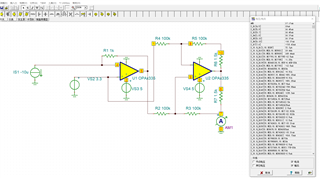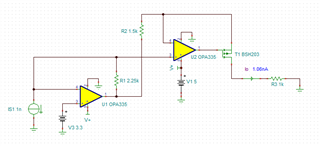Other Parts Discussed in Thread: TINA-TI, OPA2335
Hi Team,
Can you please help us with our customer's inquiry below.
I would like to ask about the logarithmic amplifier log114 datasheet, which converts negative current into positive current input to the log114 for amplification.
Is the current inversion with OPA2235 1:1? I simulated the circuit with TINA-TI, but the current output is not correct.
Simulation file to change the size of the current source, the OPA2335 output current size remains unchanged, such as input 10na, the output through the amperemeter shows 86.5uA
Can you help to verify or give me a correct current inverse current simulation file, I try to verify the simulation with TINA-TI on my computer, the circuit diagram I simulated is from the log114 Figure 9. Precision Current
Inverter/Current Source.
Sorry, I also want to ask a question, I input reverse current source, in the OPA2335 side, but also need to add bias voltage 3.3v well, if my current is less than 10na, can also use this current inverter for reverse, the manual
circuit diagram is given in 10nA to 1mA
OPAx3225 - autosav.TSCOPA2335_BSH203.TSC
Regards,
Danilo








